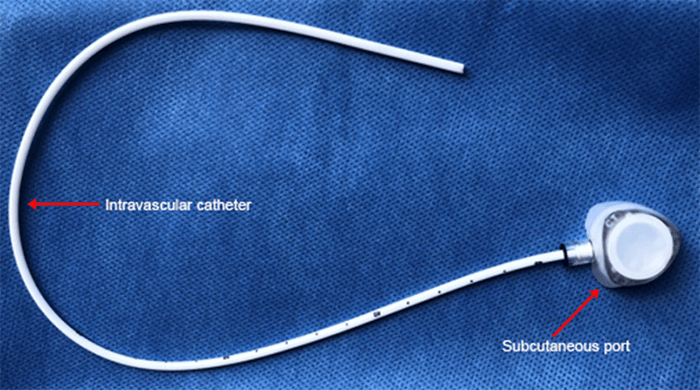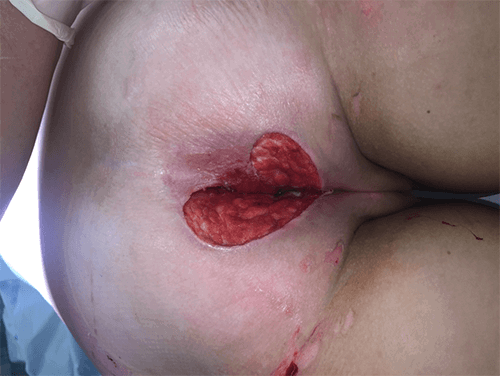The patient’s further postoperative recovery was uncomplicated. She was seen in clinic two weeks later, with healed incisions, tolerating a regular diet, and no pain.
Discussion
The appropriate treatment of patients with asymptomatic malrotation is controversial. Traditional teaching favors surgical intervention in all patients with a radiographic diagnosis of malrotation.11 However, the incidence of intestinal complications in asymptomatic adults with intestinal malrotation is low.12,13 The most dreaded complication of intestinal malrotation is midgut volvulus, but the risk of volvulus declines significantly after infancy. Most adults require surgical treatment for chronic gastrointestinal symptoms rather than volvulus.14,15 There is also growing evidence suggesting that many adults with intestinal malrotation remain asymptomatic throughout life.12
The diagnosis of appendiceal mucocele can be challenging if it is accompanied with intestinal malrotation. The patients can be asymptomatic, as in our case, or may present with abdominal pain in left lower quadrant9 or left upper quadrant8 depending on the degree of intestinal malrotation. The diagnostic work up should start with a careful physical exam. Plain radiographs, CT scan, ultrasonography (USG), colonoscopy and barium enema can provide a relatively accurate presumptive diagnosis and exclude other etiologies.16 Plain radiographs may show characteristic calcifications in a punctate or curvilinear pattern at the appendix site.16 Additionally, distended bowel loops and air fluid levels can be observed in case of ongoing intestinal obstruction.10 However, plain radiographs provide little information on the intestinal anatomy.
Abdominal CT is the procedure of choice, as it can both demonstrate the intestinal anatomy and provide accurate staging information about the tumor. Appendiceal mucoceles are typically seen as a well-encapsulated round or tubular cystic mass with low attenuation adjacent to the cecum.16 A mucinous cystadenocarcinoma should be suspected when there is soft-tissue thickening and wall irregularity without increasing appendiceal wall thickness.17 Colonoscopic findings are usually similar to the findings depicted in our case; a glossy and rounded mass protruding from the appendiceal orifice into the cecum can be seen.18 The mass may be firm or soft in consistency, and may exhibit a central indentation, known as the “cushion sign.”19 A “volcano sign” is described as the appendiceal orifice seen in the center of the mucocele protruding into the cecal wall.20 In addition to imaging, the CEA, CA19-9 and C-reactive protein (CRP) levels might be increased in patients with neoplastic appendiceal mucocele.8-10
The presence of abdominal pain in the initial presentation suggests a more complicated clinical course such as the rupture of the tumor or small bowel obstruction.8-10 A complicated clinical course may also correlate with the increased malignancy. For asymptomatic and uncomplicated cases, a laparoscopic approach can be utilized; however, an open approach may be preferred for the complicated cases.
The extent of resection of appendiceal mucoceles largely depends on the degree of adjacent tissue involvement seen on preoperative imaging.21 For non-neoplastic lesions, simple excision with clear margins is usually curative, whereas appendiceal cystadenocarcinoma may require right hemicolectomy and lymph node sampling due to the malignant nature of the disease.9 If the appendix is not ruptured, the tumor should be handled gently intraoperatively in order to avoid rupture and the spillage of mucocele content. The spillage from mucocele may lead to pseudomyxoma peritonei10 that decreases the survival of the patients significantly (reported 5-year survival 23 percent).6,8,22 This is especially important in cases with LAMN since these patients have a 100 percent 5-year survival rate if the tumor can be removed without spillage.22
Postoperative surveillance for an appendiceal mucocele will depend on intraoperative and pathologic findings. For benign neoplastic lesions, such as LAMN, patients should be followed up with yearly abdominal CT scans for 5–10 years.21,23 Carcinoembryiogenic antigen (CEA) and CA19-9 levels can also be used to detect possible recurrence of neoplastic lesions.10,24
The case presented here is interesting due to the fact that the patient had no symptoms or surrounding organ invasion despite the fairly large size of the tumor. The preoperative imaging also underestimated the size of the lesion. However, we feel that the patient underwent successful laparoscopic management.
In conclusion, a careful operative planning is necessary in cases of appendiceal mucocele with intestinal malrotation based on the clinical picture and abdominal imaging. Unruptured, asymptomatic mucoceles should be removed intact. If the mucocele is already ruptured or if the patient is symptomatic, then the tumor is most likely a neoplastic one, and a wider oncologic excision is required.
Lessons Learned
Appendiceal mucoceles accompanied with intestinal malrotation can present with a variety of symptoms depending on the level of the malrotation and the histological subtype of the tumor. An abdominal CT is helpful for both documenting the intestinal malrotation and the extent of the tumor invasion. Unruptured tumors can be safely removed laparoscopically. If the histologic subtype is non-neoplastic or an LAMN, excision with clear margins is curative. Concomitant intestinal malrotation in adults can be managed non-operatively in the absence of symptoms. If conservative management is pursued, patients should be educated on the signs and symptoms of intestinal malrotation complications that require surgical evaluation.
Abbreviations
CT: Computerized tomography
LAMN: Low-grade appendiceal mucinous neoplasm
CEA: Carcinoembryiogenic antigen
USG: Ultrasonography
CRP: C-reactive protein
Authors
Axel Rodriguez-Rosa, BS
Visiting student, Department of Surgery
University of Maryland Medical Center
Baltimore, MD
Hakan Orbay, MD, PhD
Department of Surgery
University of Maryland Medical Center
Baltimore, MD
Stephen M Kavic, MD, FACS
University of Maryland School of Medicine
Baltimore, MD
Correspondence
Stephen M. Kavic, MD, FACS
Professor of Surgery
University of Maryland School of Medicine
29 S Greene St, GS631, Baltimore, MD 21201
Phone: 410-328-7592
Fax: 410-328-5919
E-mail: skavic@som.umaryland.edu
Disclosures
The authors have no conflicts of interest to disclose.
References
- Langer JC. Intestinal rotation abnormalities and midgut volvulus. Surg Clin North Am. 2017;97(1):147-159.
- Nagata H, Kondo Y, Kawai K, et al. A giant mucinous cystadenocarcinoma of the appendix: A case report and review of the literature. World J Surg Oncol. 2016;14:64.
- Rymer B, Forsythe RO, Husada G. Mucocoele and mucinous tumours of the appendix: A review of the literature. Int J Surg. 2015;18:132-135.
- Aho AJ, Heinonen R, Lauren P. Benign and malignant mucocele of the appendix. Histological types and prognosis. Acta Chir Scand. 1973;139(4):392-400.
- Higa E, Rosai J, Pizzimbono CA, et al. Mucosal hyperplasia, mucinous cystadenoma, and mucinous cystadenocarcinoma of the appendix. A re-evaluation of appendiceal "mucocele". Cancer. 1973;32(6):1525-1541.
- Orcutt ST, Anaya DA, Malafa M. Minimally invasive appendectomy for resection of appendiceal mucocele: Case series and review of the literature. Int J Surg Case Rep. 2017;37:13-16.
- Dilley AV, Pereira J, Shi EC, et al. The radiologist says malrotation: Does the surgeon operate? Pediatr Surg Int. 2000;16(1-2):45-49.
- Yap D, Hassall J, Williams GL, et al. Appendiceal mucocoele with midgut malrotation. Ann R Coll Surg Engl. 2016;98(7):e138-140.
- Sato H, Fujisaki M, Takahashi T, et al. Mucinous cystadenocarcinoma in the appendix in a patient with nonrotation: Report of a case. Surg today. 2001;31(11):1012-1015.
- Kawashima K, Ishihara S, Amano K, et al. Nonrotation of the midgut with appendiceal mucocele in an adult. J Gastroenterol. 2001;36(1):44-47.
- von Flue M, Herzog U, Ackermann C, et al. Acute and chronic presentation of intestinal nonrotation in adults. Dis Colon Rectum. 1994;37(2):192-198.
- Malek MM, Burd RS. The optimal management of malrotation diagnosed after infancy: A decision analysis. Am J Surg. 2006;191(1):45-51.
- McVay MR, Kokoska ER, Jackson RJ, et al. Jack Barney Award. The changing spectrum of intestinal malrotation: Diagnosis and management. Am J Surg. 2007;194(6):712-717; discussion 718-719.
- Yanez R, Spitz L. Intestinal malrotation presenting outside the neonatal period. Arch Dis Child. 1986;61(7):682-685.
- Seashore JH, Touloukian RJ. Midgut volvulus. An ever-present threat. Arch Pediatr Adolesc Med. 1994;148(1):43-46.
- Madwed D, Mindelzun R, Jeffrey RB, Jr. Mucocele of the appendix: Imaging findings. AJR Am J roentgenol. 1992;159(1):69-72.
- Wang H, Chen YQ, Wei R, et al. Appendiceal mucocele: A diagnostic dilemma in differentiating malignant from benign lesions with CT. AJR Am J roentgenol. 2013;201(4):W590-595.
- Raijman I, Leong S, Hassaram S, et al. Appendiceal mucocele: Endoscopic appearance. Endoscopy. 1994;26(3):326-328.
- Mizuma N, Kabemura T, Akahoshi K, et al. Endosonographic features of mucocele of the appendix: Report of a case. Gastrointest Endosc. 1997;46(6):549-552.
- Hamilton DL, Stormont JM. The volcano sign of appendiceal mucocele. Gastrointest Endosc. 1989;35(5):453-456.
- Abreu Filho JGD, Lira EFD. Mucocele of the appendix: Appendectomy or colectomy? J Coloproctol (Rio J). 2011;31(3):276-284.
- Sugarbaker PH, Ronnett BM, Archer A, et al. Pseudomyxoma peritonei syndrome. Adv Surg. 1996;30:233-280.
- Padmanaban V, Morano WF, Gleeson E, et al. Incidentally discovered low-grade appendiceal mucinous neoplasm: A precursor to pseudomyxoma peritonei. Clin Case Rep. 2016;4(12):1112-1116.
- McFarlane ME, Plummer JM, Bonadie K. Mucinous cystadenoma of the appendix presenting with an elevated carcinoembryonic antigen (CEA): Report of two cases and review of the literature. Int J Surg Case Rep. 2013;4(10):886-888.



